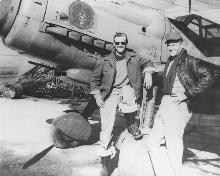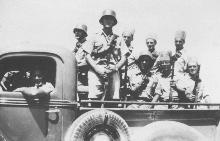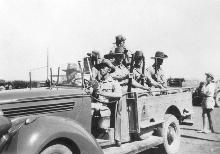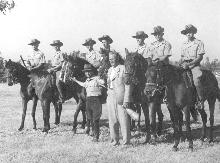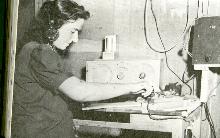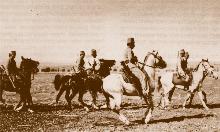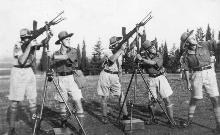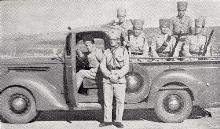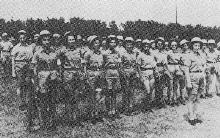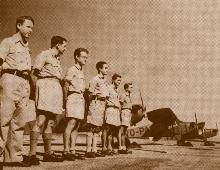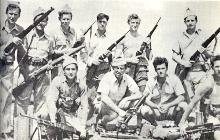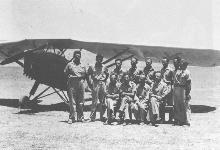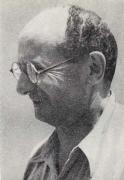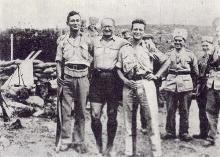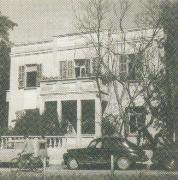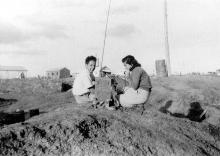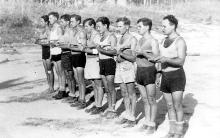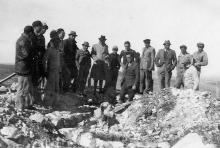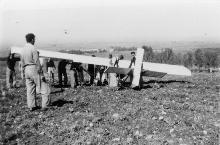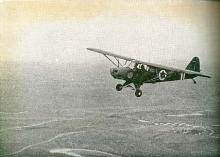| Organizational structure and combat forces |
Hish - Field Combat Corps The Field Combat Corps were established immediately after the dismantling of Fosh (Field Companies) in 1939. Hagana members, between the ages of 26-18, served in the Field Combat Corps' urban battalions and rural companies, and later in the district brigades that were formed prior to the War of Independence. Field Combat Corps comprised most of the Hagana's battalions and brigades during 1947-1948. At the beginning of the war the brigades was separated from the districts, which remained responsible for the defense of their regions. Chim - Home Guard Men between the ages of 27-50, and women up to the age of 35 were designated to protect the settlements and the home front. They operated wireless communications, first aid and civil services. Some of them served in the mobile units and in the combat brigades. Although the Garrison Forces and the Field Corps were both established at the same time, the Field Corps and the Palmach were the main combat forces. The Jewish Police Force - Notrut The Palestine police force included voluntary units (mostly Jewish and some Arab) who joined the British police as an auxiliary corps. The Notrim included the British police force; Jewish Settlement Police that included the Mobile Guards; Notrim that served in the Special Night Squads, British army units stationed next to the Northern border fence, Coast guard , Water works guards , British Detention Camp guards, Airfield guards, General duty guards, Special Duty guards, Electric Company guards and Potassium Company guards. The Notrim were engaged as auxiliary aids to the police. Some were unpaid, but were allowed to carry weapons. Others carried weapons only when necessary. The weapons, that included mostly British rifles, were held in legal weapon depositories in the Jewish settlements, and could only be used with the permission of the British commander. Some of the Notrim were equipped with shotguns and flare guns. Mobile Guards were equipped with rifles and machine-guns. Settlements and corporations such as the Electric Company and the Potassium Company funded the Notrim. The Jewish Agency funded some of the equipment, such as the Mobile Guards patrol vehicles. The Jewish Settlement Police was the largest Notrut formation, with 1,300 policemen and 13,000 part-time servicemen; it operated from 1939 until the establishment of the State of Israel. It organized all the Notrim within regional battalions. The officers were British and the others were mainly Jewish. JSP members were allowed to use weapons in settlement regions and operated according to the Field Companies (Fosh) and SNS methods, conducting day and night motorized foot patrols and ambushes. Some of the policemen served in the Mobile Guards, a motorized squad, known for its high mobility abilities. The battalions were under British command and Hagana regional headquarters command. British defense needs determined the number of Notrim. As a rule, the British wanted to reduce the numbers, while the Jewish Agency strove to enlarge the numbers, viewing the Notrut as the Hagana's legal arm. The Notrim trained in Hagana courses including Platoon commander training course and Regional Commander training courses, and some became senior commanders and instructors. Thousands of Hagana members trained under Notrut cover, and with their weapons, almost in the open, transported and concealed numerous weapons. Gadna - Youth Battalions The Hagana's national youth organization was (illegally) established in 15.5.194, and united all regional youth units. The Gadna aimed at "training all Jewish Israeli youth to defend the country", and was led by a national youth commanding officer who was a member of the General Staff. Gadna membership was voluntary, and boys and girls aged 15 and over were allowed to volunteer. Volunteers had to learn Hagana principles and pass tests of courage and reliability before being sworn in. Volunteers consisted mainly of youth from agricultural schools and rural settlements and had to learn 'Haganah' principles and engage in tests of courage and reliability, before being sworn in. Subjects studied in the Gadna: Sash- Functional Sports, Defense Sports- boxing, Jujitsu, Kapap (face to face combat using poles), Tas (Drills), Field training, Camping, First aid, Signals & Wireless, Topography, Field games, Field marches, Reconnaissance and Weaponry, in addition to extensive ideological and educational activities. Gadna commanders were graduates of the Hagana's Squad and Platoon commander training courses. Boys and girls trained together twice a week in the evenings, and 2 Saturdays a month, participating in courses and marches during school vacations. Gadna members participated in operational activities including pamphlet distribution, wireless communication, surveillance and reconnaissance, assisting with Illegal Immigration toward Mandatory Palestine and fortifications. They participated in demonstrations and assemblies held by the National Institutions. Suitable members participated in additional courses such as: First aid, Wireless & Signals, Reconnaissance and Weapons. During the War of Independence Gadna members over the age of 17 enlisted into the combat forces. Gadna members numbered 18,000 boys and girls engaged in transporting weapons, operating wireless communications, and assisting with munitions and fortifications, and manning posts and road barriers. Gadna members and fought side by side soldiers in Jerusalem, with 15 years old Gadna members guarded their positions together with older fighters. Younger Gadna members aged 12 to 14 assisted with wireless communications and hospital fortifications. Gadna members also fought in Tiberius and in Zefath. They defended downtown Haifa and fought in rural settlements. The Gadna defended the Lebanese border while Yiftach Brigade was transferred south, and suffered many fatalities. Chagam - Extended Physical Training Following the Arab Uprising of 1936-1939, Dr. Arthur Biram, headmaster of the HaReali School (a secondary school with a scientific curriculum) in Haifa initiated Chagam (Physical Training). A national Chagam officer was appointed and put in charge of all physical exercise training in high schools. Chagam was preparatory training for joining the Gadna, and included Drill Training, Kapap, Field Training once a month and Functional Sports. Students participated in Chagam instruction and squad commander training courses. Shai - the Hagana's National Information Service Advanced intelligence is vital for the success of any army operation, and the roll of Intelligence is to supply the army and its commanders with intelligence. Shai was established in 1941 and gathered political and military information concerning the British army, the Arabs, Jewish Extremist splinter groups, communists etc., and accomplished some impressive achievements while doing so. The Hagana began gathering vital information back in the 20's. In 1933 the Jewish Agency established a national intelligence service, and an Arab department led by Eliyahu Sason. In parallel, the Hagana operated RN- counterespionage. Shai was based on both these services, and thus became the IDF's intelligence branch during the War of Independence. Shai operated in several areas: British government and army: Shai members succeeded in wiretapping and deciphering British police transmissions, connecting to the phone lines of British officials, and tapping their conversations with England and Arab leaders. Among others, they wiretapped and deciphered conversations of the High Commissioner. Shai managed to get hold of the British code book and thus succeeded in deciphering telegrams between London and Jerusalem. The Hagana received information from a British collaborator about a wide search & arrest operation, later to be known as the Black Sabbath. The Arabs: Information was gathered by officers in various sections and districts by Arabic speaking Shai operatives, who prepared 'Arab villages files'. Palmach reconnaissance personnel updated maps and marked military significant attack & sabotage objectives. Shai gathered information relating to population, names of leaders, instigators etc. During the War of Independence, information relating to every Arab village and neighborhood was available to the regional force commanders. Shai supplied the Jewish Resistance Movement with the intelligence enabling them to fight against British government, acquire weapons from British army camps, while engaging collaborators, informants and volunteers from the British government, police and army. Shai operated regularly among the extremist sprinted groups - Etzel and Lechi, and among both Jewish and Arab members of the communist party. During the War of Independence, Shai managed to attain the British evacuation dates from Jerusalem and from other places, which enabled Jewish occupation of the evacuated areas and facilities. Palmach - Hagana mobile striking force (Plugot Hamahatz) The National Command established the Palmach in 1941in order to prevent German and Italian armies from invading Palestine. The order for the establishment of the 6 platoons of volunteers was issued by the head of National Command in 'Order of the day no.2', published in 15.5.1941. The 6 Platoons were a meeting place where volunteers trained, but as the axis forces approached during the months of May-July, 1942, Palmach members trained with the British army. During June 1941, Palmach members served as guides and patrolmen during the invasion of the Australian forces into Vishi held Syria and Lebanon. British collaboration and funding of the Jewish organizations ceased once the German invasion threat was over. As a result a "Work &Training" agreement was formed in order to establish the Palmach as a regular army force, and the agreement was represented by the Palmach insignia of 2 spikes and a sward. According to the Hachsharot Agreement formed between the youth movements and Palmach General Staff in 1944, youth movement graduates had to serve in the "Hachsharot" (groups of young men and women who joined the Palmach, some of them from their youth movements, preparing to be settlers) for 2 years. At the end of their mandatory service, they joined the Palmach's reserve forces and many founded new settlements. Several areas were covered during the mandatory service: Physical fitness training, full individual combat training, in the sense of "Every squad commander is a general", platoon and brigade training, reconnaissance, including areas where access was forbidden by the British. From the end of World War II until the War of Independence, the Palmach led the armed struggle against British government policy, and played a major roll in illegal immigration and launching new settlement operations. During these years the Palmach grew from 6 platoons to 4 battalions on the eve of the War of Independence, and into 3 brigades comprising 9 battalions during the war itself: Yiftach, Harel and Negev Brigades. At the onset of the war, the Palmach was the main fighting force leading dozens of operations in various fighting sectors against Palestinian Arabs, and those sent to help them, especially in transport and retaliation operations. Palmach brigades joined other Hagana brigades after the declaration of independence, and later on became part of the IDF. They participated in deterring invasions, counter attacks, and the capture, occupation and control of occupied territories. The Palmach's General Staff was dismantled in the fall of 1948. Its brigades were dismantled at the end of the war in 1949, and the soldiers were assigned to other brigades. Discharged Hachsharot members established 40 new settlements and reinforced 20 veteran settlements. During the 8 years of its existence, 7,000 men and women served in the Palmach, 70 of who were killed in action before the War of Independence and 1,134 during the war itself. Organizational structure in 1947 Hagana members: On the eve of the War of Independence - 46,000 Recruitment abroad: Gahal - 15,000 - 20,000 Machal (Foreign Volunteers) - 5,000 Officers training course graduates (who became IDF commanders) - 1,412 Stockade and Watchtower settlements founded by the Hagana - 50 Settlements founded by the Hebrew Resistance Movement- 49 Settlements founded by the Palmach - 9 Settlements founded during the War of Independence (up to July, 1949) - 89 Illegal Immigrants brought to Israel by the Hagana - 96,000 Illegal Immigrants brought to Israel by the Revisionist Movement - 15,000 Illegal Immigrants brought to Israel by private bodies - 10,250 Hagana Illegal Immigration during the years 1934-1948 - 141 Illegal ships organized by the Revisionists until 1940 - 24; 1 in 1947 Hagana ships transporting 70,000 Illegal Immigrants during 1945-1948 - 64 Hagana members sentenced to over 6 month in prison - 200 | |||||||||||

